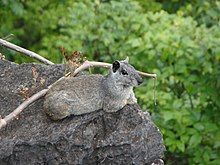Acrobatic cavy
| Acrobatic cavy | |
|---|---|
 | |
Conservation status | |
| Scientific classification | |
| Domain: | Eukaryota |
| Kingdom: | Animalia |
| Phylum: | Chordata |
| Class: | Mammalia |
| Order: | Rodentia |
| Family: | Caviidae |
| Genus: | Kerodon |
| Species: | K. acrobata |
| Binomial name | |
| Kerodon acrobata Moojen et al., 1997 | |
The acrobatic cavy (Kerodon acrobata) also known as the Acrobatic Moco and Climbing Cavy is a cavy species native to Brazil. It is found from Goiás state to Tocantins state, west of the Espigão Mestre, Serra Geral de Goiás, and is also found in Terra Ronca State Park.[1]
Diet
They are herbivores known to eat a generalized diet of leaves, flowers, bud, bark and fruit[2][3] from 16 different types of native plantations.
Habitat
Found in fragments of dry forest associated with limestone outcrops in the Cerrado savanna of central Brazil.
Appearance
Acrobatic Cavies are a large rodent averaging 1 kg in weight, their fur ranges from dark grey to light brown with orange-brown feet, mostly observed on hindfeet. Their tails are vestigial.
Phylogeny
The Acrobatic Cavy belongs to the order Rodentia, in the family Caviidae (Guinea-pig like rodents) which has two subfamilies (formerly three) with Acrobatic Cavies being in a new subfamily Hydrochaerinae alongside Capybaras and the closely related Rock Cavy from Eastern Brazil.
References
- ^ a b Roach, N. (2016). "Kerodon acrobata". IUCN Red List of Threatened Species. 2016: e.T136222A22190183. doi:10.2305/IUCN.UK.2016-2.RLTS.T136222A22190183.en. Retrieved 12 November 2021.
- ^ "Kerodon acrobata Moojen, Locks & Langguth 1997 - Plazi TreatmentBank". treatment.plazi.org. Retrieved 2022-06-19.
- ^ de Souza Portella, Alexandre; Vieira, Emerson M. (2016-07-01). "Diet and trophic niche breadth of the rare acrobatic cavy Kerodon acrobata (Rodentia: Caviidae) in a seasonal environment". Mammal Research. 61 (3): 279–287. doi:10.1007/s13364-016-0275-z. ISSN 2199-241X. S2CID 2069785.
"Kerodon acrobata Moojen, Locks & Langguth 1997 - Plazi TreatmentBank". treatment.plazi.org. Retrieved 2022-06-19.
de Souza Portella, Alexandre; Vieira, Emerson M. (2016-07-01). "Diet and trophic niche breadth of the rare acrobatic cavy Kerodon acrobata (Rodentia: Caviidae) in a seasonal environment". Mammal Research. 61 (3): 279–287. doi:10.1007/s13364-016-0275-z. ISSN 2199-241X.
- v
- t
- e
- Kingdom: Animalia
- Phylum: Chordata
- Class: Mammalia
- Order: Rodentia
- Suborder: Hystricomorpha
| Cavia (Guinea pigs) |
|
|---|---|
| Galea (Yellow-toothed cavies) |
|
| Microcavia (Mountain cavies) |
|
| Dolichotis |
|
|---|---|
| Pediolagus |
|
| Hydrochoerus |
|
|---|---|
| Kerodon (Rock cavies) |
|
 | This article about a rodent is a stub. You can help Wikipedia by expanding it. |
- v
- t
- e











